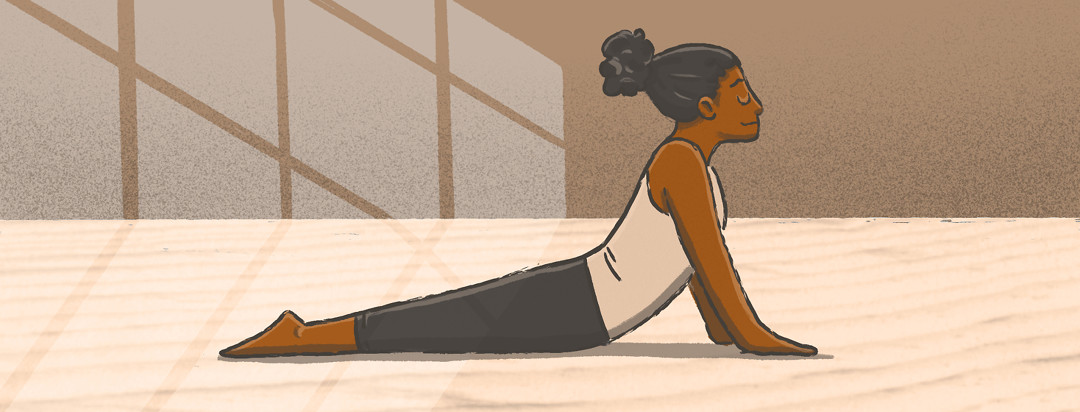When the Massage Therapist Is Out and You Need Relief Now
It’s really too bad we can’t physically distance ourselves from our MS symptoms.
One of my symptoms, spasticity, cannot be ignored. It flares at the least convenient times.
- Persistent hiccups (spasticity of the diaphragm) ruin meals
- The dreaded “MS hug” makes for uncomfortable breathing
- Leg cramps at 2 am are no joke
The pain and immediacy of these symptoms leave me anticipating my next trip to the massage therapist. Unfortunately, I can’t always get an appointment. What do I do instead?
Drug-free options
I seek nonpharmaceutical options first and follow these protocols between trips to the massage therapist.
Step One: Yoga
Sometimes, settling into a gentle, deep stretch is all I need. Specific poses that help include:
- A modified down-dog releases mid-back demons (I use the kitchen counter to spare my wrists and ankles)
- An up-dog pose relieves lower back stiffness
- I’ve practiced “cats and cows” (on hands and knees, arching and sagging the midsection) for girdle band sensation all my life
- Half lotus and pigeon pose are great hip openers
Don’t forget yogic breathing: inflate your belly, inhaling deeply, drawing that breath up through your spine, holding it gently, then exhaling it like running water down your shoulders.
Check for and release tight spots, too. For me, these include my face, jaw, glutes, and hands. Clutching maintains unnecessary tension, creating conditions for more muscle spasticity.
Step Two: Self-massage
I’m not great at massaging my own muscles, thanks to arthritis. I do what I can and enlist my spouse for those hard-to-reach areas. It’s imperfect but better than nothing!
Step Three: Use foam rollers and bolsters
I find that my back appreciates a little reverse positioning. My sitting posture as a writer leaves me slouchy. I use the foam roller or bolster pillow from my yoga supplies, aligning my spine in parallel fashion over either. Pillows under knees give the lower back easy relief, as well.
Step Four: Zap it with a TENS unit!
Sometimes these efforts are for naught—the cramps and spasms just won’t go away. My biggest trouble areas? Wrists, shoulders, neck, and mid-back. This is when I get out my personal pain terminator, the TENS unit.
TENS stands for transcutaneous electronic neurostimulation. You attach a pair of electrodes wherever your muscles jump and clutch, then activate electric pulses to these areas.
This does a couple of things: It releases dopamine which masks discomfort, and it loosens tight muscle tissue. I wear mine under my clothes, easy peasy.
Follow all directions for a TENS unit; there are places you shouldn’t place these electrodes, generally near the heart and upper cervical spine.
You can buy TENS online or at most drugstores; they don’t cost a lot. Mine’s wireless and comes with multiple gel pads for attaching the electrodes to the skin.
I never go anywhere without my TENS unit; it has provided me relief for years.
Medication options
Then there are those days when non-drug approaches just aren’t enough. On these “hug” days, the girdle band sensation comes as a sneak attack. That’s when I go to my pharmaceutical arsenal.
Option One: Magnesium and other supplements
Magnesium is a muscle-relaxing mineral. You’ll need to find the dose that works best for you; too much of it gives me GI problems. However, topical sprays and ointments help.
Also, certain foods high in magnesium include avocados, nuts, leafy greens, and dark chocolate.
Other minerals that help relax muscles include calcium and potassium. I take a magnesium-calcium supplement, but when it comes to potassium, I eat a lot of fresh fruits and vegetables. Oranges, bananas, broccoli, and potatoes are loaded with this vital mineral.
Option Two: Ibuprofen
This NSAID works so well, I never go anywhere without it.
My neurologist permitted me four 100mg mini capsules at a time. Usually, one dose takes care of the problem (especially at bedtime).
Large doses of ibuprofen aren’t recommended on a regular basis. However, when spasms make it nearly impossible to breathe, ibuprofen is more than justified. Ask your neurologist what type of pain reliever and dosage work best for you.
Option Three: Baclofen
I asked for a baclofen prescription in December 2018 and am so glad! I take a bare minimum of this antispasmodic muscle relaxer (10mg at bedtime, and 10mg only when all other relief attempts fail). It works well, but it still has risks and side effects.
I always carry baclofen with me for the inevitable surprise spasms, such as during my daughter’s college graduation service in 2019. I wasn't about to miss that special event over an MS hug!
Again, ask your neurologist for guidance on using this medication.
Until next time...
I look forward to my massage therapist’s healing hands in the future. But for now, these options should take care of my pain and discomfort until we meet again. I hope they help you, too!

Join the conversation